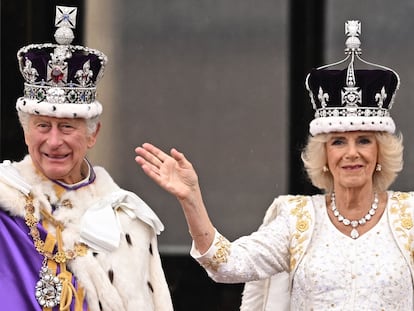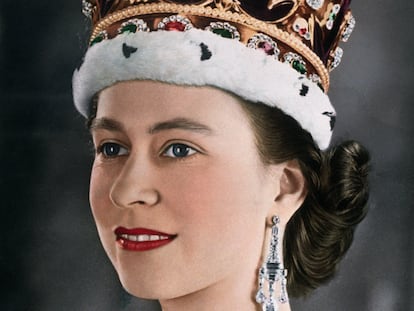The Scottish ‘coronation’ of Charles III: Less pomp and less enthusiasm
The British royals traveled to Edinburgh to receive the crown jewels and strengthen ties with a territory where the movement for independence has gained traction in recent years
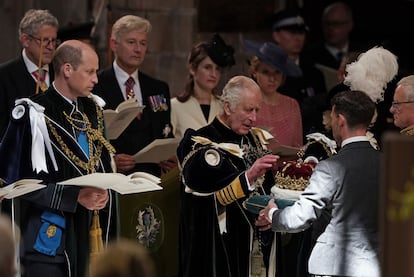
The Royal Mile is the central artery of the old part of Edinburgh. It joins the castle that overlooks the city from its imposing height alongside Holyrood Palace, the British monarchs’ official residence in the Scottish capital. It is located on a narrow gorge, lined on either side with stone houses and cobblestone sidewalks, where the echo makes every cry of protest sound twice as loud. This Wednesday, King Charles III and Camilla could clearly hear the cries of dozens of supporters of the anti-monarchist organization Republic when they got out of their maroon Rolls Royce—claret is the royal family’s official color—to enter the cathedral of St. Giles: “Not my king, not my king!” shouted the demonstrators. There’s been an extensive police presence along the route, but unlike last May’s coronation ceremony in London, there has been no attempt to hide the protests behind metal sheeting and the organizers haven’t been arrested. The BBC has also been generous in showing the presence of dissidents and allowing their slogans to be heard.
Prince William and Princess Kate of Wales joined Charles III and Camilla on the trip to the Scottish capital.
Popular jargon refers to the Edinburgh ceremony as the “Scottish coronation,” although technically that is not the case. There is only one official coronation, and Charles III’s took place on May 6 at Westminster Abbey. The monarch is now participating in the so-called “Holyrood Week,” which is dedicated to celebrating Scottish culture, traditions, history and national pride. In that sense, the event puts something like a final touch on the new king’s consecration. Before Charles and Camilla arrived at the cathedral, the Honors of Scotland, Britain’s oldest crown jewels, had arrived there in another Rolls Royce. The crown jewels are the crown, scepter and sword of state (or Elizabethan sword); Scottish royalty like Mary I and James VI were crowned with them. They were also hidden in the castle for centuries to preserve them from Oliver Cromwell’s republican wrath and rediscovered in 1818 by a group of researchers that included writer—and Scottish symbol par excellence—Walter Scott.

“All of this is an intrinsic part of what makes a nation a nation. It is intrinsic to its identity, its history and its culture. And Charles is very proud of British and Scottish cultures and traditions,” a University of St. Andrews history professor argued enthusiastically on the BBC.
As in the London ceremony, the traditionalist king was aware of the need to modernize and popularize monarchical rites, no matter how ancient they may be, in homeopathic doses. The so-called People’s Procession, made up of schoolteachers, firemen, members of the coast guard, doctors, nurses, postal workers and even an immigrant who was granted the right of asylum in Scotland, paraded along the Royal Mile before the royal procession left the castle. Behind them, 700 members of the armed forces and dozens of grey horses from the royal stables in Edinburgh followed. On both sides of the street, thousands of citizens attended the parade for their own reasons, whether out of enthusiasm, curiosity or royalist devotion. As in London, the paradegoers were part of a minority in a city that enjoyed the holiday but was not overly enthusiastic about the royals’ arrival.
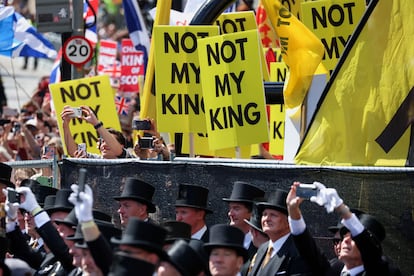
Old rites, new guests
The three symbols of power—the crown, the scepter and the sword—were presented separately to Charles III, to whom allegiance was sworn; in return, he was asked to obey and uphold Scottish laws. “So help me God, I promise,” the monarch repeated on each occasion.
Shortly before, Scotland’s first minister, Humza Yousaf, a Muslim of Pakistani descent and the leader of the pro-independence Scottish National Party (SNP), had read a psalm from the Old Testament. “The heavens declare the glory of God, and the firmament showeth the work of his hands.” Yousaf has taken up his predecessor Nicola Sturgeon’s plans to push for a referendum on Scotland’s secession from the rest of the United Kingdom. But the party is currently under investigation for its alleged irregular financial dealings, so it is experiencing a moment of uncertainty and weakness. The cause of Scottish independence is currently on the back burner. And, curiously, the SNP’s plans for separation have always included the idea of Scotland remaining part of the British monarchy, with Elizabeth II (then) or Charles III (now) continuing as its head of state.
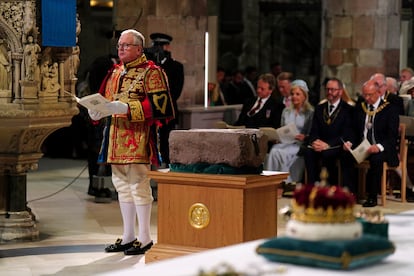
Representatives of the Muslim, Hindu, Jewish and Buddhist faiths also participated in the thanksgiving service at the cathedral. Ceremony attendees at St. Giles sang “God Save the King” together after the monarchs were presented with the so-called Stone of Destiny, the 150-kilogram rock on which Scottish kings were crowned. The Stone of Destiny symbolizes Scottish sovereignty. It had been housed in Westminster Abbey, and a group of Scottish students broke it in two when they tried to steal it in 1950. In 1996, when Scotland was granted political autonomy, then-British Prime Minister Tony Blair returned it to Edinburgh Castle. On May 6 of this year, the Stone of Destiny was returned to London and placed under the throne of Edward the Confessor for Charles III’s coronation.
To conclude the ceremony, twenty-one cannon volleys were fired from the castle’s parade grounds, and the sound of bagpipes bid Charles and Camilla farewell as they set off on their journey to Holyrood palace. They left behind cries of protest in the streets, which blended with the music, street hustle and bustle and a certain civilized indifference.
Sign up for our weekly newsletter to get more English-language news coverage from EL PAÍS USA Edition
Tu suscripción se está usando en otro dispositivo
¿Quieres añadir otro usuario a tu suscripción?
Si continúas leyendo en este dispositivo, no se podrá leer en el otro.
FlechaTu suscripción se está usando en otro dispositivo y solo puedes acceder a EL PAÍS desde un dispositivo a la vez.
Si quieres compartir tu cuenta, cambia tu suscripción a la modalidad Premium, así podrás añadir otro usuario. Cada uno accederá con su propia cuenta de email, lo que os permitirá personalizar vuestra experiencia en EL PAÍS.
¿Tienes una suscripción de empresa? Accede aquí para contratar más cuentas.
En el caso de no saber quién está usando tu cuenta, te recomendamos cambiar tu contraseña aquí.
Si decides continuar compartiendo tu cuenta, este mensaje se mostrará en tu dispositivo y en el de la otra persona que está usando tu cuenta de forma indefinida, afectando a tu experiencia de lectura. Puedes consultar aquí los términos y condiciones de la suscripción digital.
More information
Últimas noticias
Welcome to the post-religion era: The idea of Christianity as the absolute truth has become obsolete
‘I thought you would like it’: The risky sexual practice popularized by TV shows and TikTok
The digitalization of tourism: ‘They promise experiences and gave us the worst possible one’
Mexican peso defies uncertainty with forecasts of a new period of stability in 2026
Most viewed
- Sinaloa Cartel war is taking its toll on Los Chapitos
- Reinhard Genzel, Nobel laureate in physics: ‘One-minute videos will never give you the truth’
- Oona Chaplin: ‘I told James Cameron that I was living in a treehouse and starting a permaculture project with a friend’
- Why the price of coffee has skyrocketed: from Brazilian plantations to specialty coffee houses
- Silver prices are going crazy: This is what’s fueling the rally

